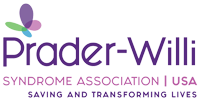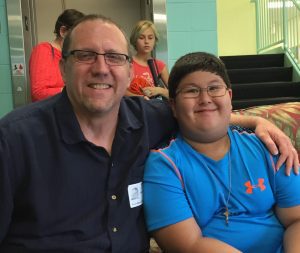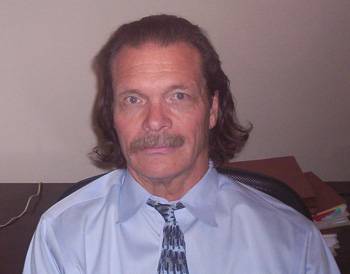contributed by Anne Fricke
The intention of this series is to shed light on the process of enrolling and participating in a clinical trial, as well as to create a space to openly share the many emotions that are involved when a family decides whether or not to join. Part of the decision-making process should certainly consider whether your family has the time and the resources to participate. It is a commitment, but many believe it to be a worthy one.
When Freya and I began this journey into the Pitolisant trial, I was pleasantly surprised to learn how many of the details the drug company takes care of, including travel plans and fees. They have been very transparent about what the trial involves, any potential risk factors, and making sure that Freya is involved in these conversations. Of course, the trial site can’t figure out the life details for our family, such as who Freya’s younger sibling stays with while we’re gone if her dad is out commercial fishing, or how we do math in an airport terminal with a ruler app on my phone because we forgot the actual ruler at home. But those are manageable, especially when flights are scheduled and hired drivers pick us up at the airport.
I can’t speak to all clinical trials, but I imagine many of the details are the same. These trial sites want participants involved. I’m assuming they realize the importance of helping families get to their sites and successfully complete the trial. So, while I can only speak about the trial we are involved in, I believe it is worth at least a phone call with any trials you may be interested in to learn the details of how they assist families in participating.
Below is a rundown of our initial steps and what happened at our first appointment – the screening. Again, please note these steps are specifically for the Pitolisant trial and you should reach out to other trials for clarification on their expectations. Hopefully by recounting our process, we can help families have a clearer understanding of what enrolling in a clinical trial may look like, thus helping you decide whether it is a right fit for your family.
Initial Steps:
Locate a trial site near you, or where you would be willing to travel to.
Use the email listed for that site to reach out and let them know of your interest.
You will receive an email to follow up with a phone call.
The initial screening is a phone call. If approved, an in-person appointment will be scheduled.
Please note that being approved by phone does not mean you are in the trial. You may attend the in-person appointment and still be denied. If you are denied, know that it is for a good reason and that you still helped participate in PWS research.
They do ask that there be one designated caregiver for the duration of the trial who can attend the appointments and oversee the interviews and daily diaries.
First appointment – Screening: 3 hours
Travel plans: Travel plans were made by a travel agency. Travel expenses such as flights, hotels, and transportation were paid for in advance. Travel expenses like food, parking fees, or ride share like Uber were reimbursed afterwards.
Paperwork: There was a small stack of paperwork to fill out before the appointment and I was asked to bring paperwork to document Freya’s medical history – PWS diagnosis confirmation from a geneticist (if you do not have this, they will confirm with a blood draw), sleep studies, surgeries, hospital visits, doctor contact information, etc. Once there, we had a larger stack of paperwork that the doctor walked us through. This involved all the details of the trial, the schedule, the potential risks, the clarification that Freya could not join any other studies during the duration of this trial, or take certain medications or herbs or supplements (I’ll touch on that in a later blog) etc. Freya and I were both asked to sign consent forms. The doctor assured Freya that she could stop the trial at any time, and he would not have his feelings hurt.
Questionnaire: I was asked to fill out a questionnaire about Freya’s symptoms and behaviors. One very important thing to note is the need to be honest and not overstate the behaviors/symptoms to get into the trial. Providing overstated or conflated information skews the data and, I’m guessing, could potentially harm your child. The medication is for people who need it. If your child is not exhibiting the symptoms the drug maker is looking for, or to the degree necessary, the medication will likely not have a positive effect on him/her.
Health assessment/lab work: At every in-person appointment including this one, medical personnel need to run some routine tests. These tests include height and weight, a urine sample, blood work, and an EKG (where they put sticky patches hooked to wires in various places on the body to test heart function). Freya gets nervous sometimes because she has had some blood draws from people who were unfortunately not very skilled. She asked the doctor if he knew what he was doing and he responded, “I watched a YouTube video.” Freya was able to appreciate the joke and laughed, helping her to feel more comfortable.
Trial app: Part of the screening process for this particular trial is to look at how the participant sleeps at night. While in the office, site personnel helped get an app set up on my phone where I was asked to document her sleep schedule for 10 days. Later on, this app will be used as a daily dosage diary, questionnaires on behavior and symptoms, and for virtual appts. For the sleep diary section, caregivers are simply asked to note what time the participant went to bed, and what time they woke up, to determine if they are getting enough sleep at night. They ask that you do this for 10 consecutive days after this initial screening appt. This trial is for excessive daytime sleepiness so it is important they rule out other factors in what may be causing the EDS. Again, please note that it is critical to a successful study that you are honest about these details.
Before we left, we scheduled the next appointment in hope that Freya would be accepted into the trial. We had a few hours before it was time to head to the airport. We took an Uber to the beach, ate lunch and had a post-blood-draw treat (something we began years ago), played games in the arcade, and waded into the ocean. When it was time, we walked the few blocks to our hotel where a driver picked us up and took us to catch our flight.
I’d be dishonest if I didn’t share that part of me hoped she wouldn’t be eligible for this trial. Putting trust in a pharmaceutical trial is not a typical feeling for me and I had my doubts. If you’d like to begin the story of those mixed emotions and how Freya and I came to the decision to enroll in this trial, you can read “How We Got Here”. At this point of the journey, traveling home from our first screening appointment, I still wasn’t convinced we were making the right decision. But a few weeks later, after a wait that involved some flagged bloodwork and a hunt for a decade old sleep study result, Freya was accepted into the trial!
We’re in it now. Struggling emotions on my part or not, we are committed.
Share this!





 Perry A. Zirkel has written more than 1,500 publications on various aspects of school law, with an emphasis on legal issues in special education. He writes a regular column for NAESP’s Principal magazine and NASP’s Communiqué newsletter, and he did so previously for Phi Delta Kappan and Teaching Exceptional Children.
Perry A. Zirkel has written more than 1,500 publications on various aspects of school law, with an emphasis on legal issues in special education. He writes a regular column for NAESP’s Principal magazine and NASP’s Communiqué newsletter, and he did so previously for Phi Delta Kappan and Teaching Exceptional Children. Jennifer Bolander has been serving as a Special Education Specialist for PWSA (USA) since October of 2015. She is a graduate of John Carroll University and lives in Ohio with her husband Brad and daughters Kate (17), and Sophia (13) who was born with PWS.
Jennifer Bolander has been serving as a Special Education Specialist for PWSA (USA) since October of 2015. She is a graduate of John Carroll University and lives in Ohio with her husband Brad and daughters Kate (17), and Sophia (13) who was born with PWS. Dr. Amy McTighe is the PWS Program Manager and Inpatient Teacher at the Center for Prader-Willi Syndrome at the Children’s Institute of Pittsburgh. She graduated from Duquesne University receiving her Bachelor’s and Master’s degree in Education with a focus on elementary education, special education, and language arts.
Dr. Amy McTighe is the PWS Program Manager and Inpatient Teacher at the Center for Prader-Willi Syndrome at the Children’s Institute of Pittsburgh. She graduated from Duquesne University receiving her Bachelor’s and Master’s degree in Education with a focus on elementary education, special education, and language arts. Evan has worked with the Prader-Willi Syndrome Association (USA) since 2007 primarily as a Crisis Intervention and Family Support Counselor. Evans works with parents and schools to foster strong collaborative relationships and appropriate educational environments for students with PWS.
Evan has worked with the Prader-Willi Syndrome Association (USA) since 2007 primarily as a Crisis Intervention and Family Support Counselor. Evans works with parents and schools to foster strong collaborative relationships and appropriate educational environments for students with PWS. Staci Zimmerman works for Prader-Willi Syndrome Association of Colorado as an Individualized Education Program (IEP) consultant. Staci collaborates with the PWS multi-disciplinary clinic at the Children’s Hospital in Denver supporting families and school districts around the United States with their child’s Individual Educational Plan.
Staci Zimmerman works for Prader-Willi Syndrome Association of Colorado as an Individualized Education Program (IEP) consultant. Staci collaborates with the PWS multi-disciplinary clinic at the Children’s Hospital in Denver supporting families and school districts around the United States with their child’s Individual Educational Plan. Founded in 2001, SDLC is a non-profit legal services organization dedicated to protecting and advancing the legal rights of people with disabilities throughout the South. It partners with the Southern Poverty Law Center, Protection and Advocacy (P&A) programs, Legal Services Corporations (LSC) and disability organizations on major, systemic disability rights issues involving the Individuals with Disabilities Education Act (IDEA), Americans with Disabilities Act (ADA), and the federal Medicaid Act. Recently in November 2014, Jim retired.
Founded in 2001, SDLC is a non-profit legal services organization dedicated to protecting and advancing the legal rights of people with disabilities throughout the South. It partners with the Southern Poverty Law Center, Protection and Advocacy (P&A) programs, Legal Services Corporations (LSC) and disability organizations on major, systemic disability rights issues involving the Individuals with Disabilities Education Act (IDEA), Americans with Disabilities Act (ADA), and the federal Medicaid Act. Recently in November 2014, Jim retired.